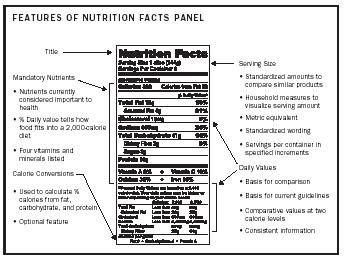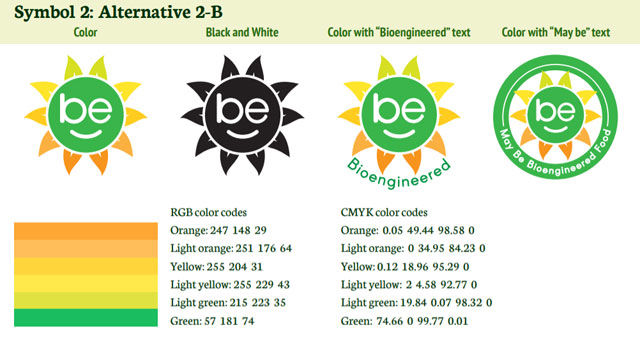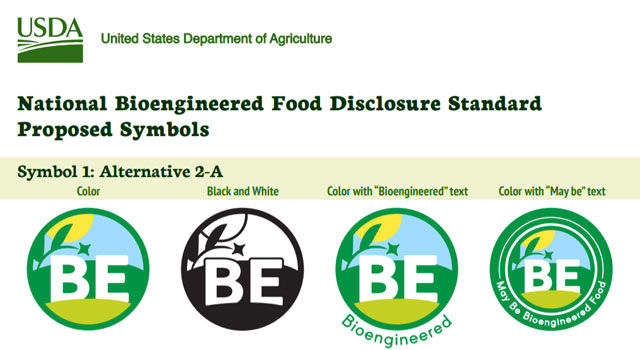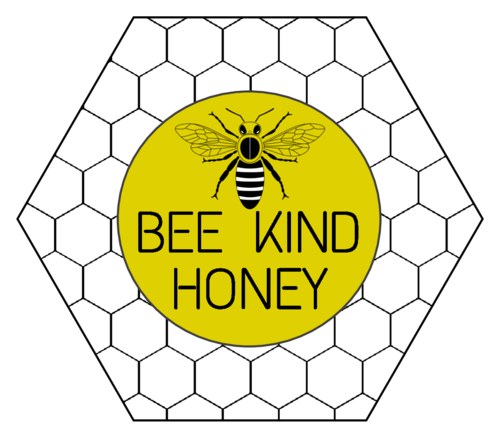42 information found on food labels
Food Labels Explained - Farm Aid There are many different food labels that contain information about how food was grown or processed. However, some labels can be misleading. Below are examples of labels to look for and ask questions about at the store or market where you see them. ... Organic labels can be found on produce, dairy, meat, processed foods, condiments and ... Understanding Food Labels | The Nutrition Source | Harvard T.H. Chan ... Understanding Food Labels The information on food labels is intended to help consumers become savvy about their food choices. The front, back, and sides of a package are filled with information to inform us what the food contains and to provide guidance in making healthier selections of processed foods.
Food labels & nutritional information | Raising Children Network Food labels are included on all food products, except for very small packets and fresh foods like fruit, vegetables and local bakery or organic products. Food labels: tell you what ingredients and/or additives are in the food give you nutritional information about the food and food storage instructions tell you who manufactured the food.

Information found on food labels
Food Labels 101: Understanding the Nutrition Facts Label A sodium level of 140 mg or less on the nutrition facts label is considered low sodium. This is an essential number to look for when reading the label. Total Carbohydrates - Fiber and Sugar Foods high in fiber can be beneficial to a healthy diet, as fiber helps manage blood sugar levels and can lower cholesterol. USDA ERS - Food Labeling Manufacturers with $10 million or more in annual sales were required to switch to the new label by January 1, 2020; manufacturers with less than $10 million in annual food sales had until January 1, 2021 to comply. Future research can investigate whether the changes improved the diet quality of U.S. consumers. About food labels - Canada.ca By law, most packaged food must be labelled with: a nutrition facts table, which gives you information on: serving size. calories. nutrients. percent daily values (% DV) an ingredient list, which lists all the ingredients in a food by weight. this begins with the ingredient that weighs the most and ends with the ingredient that weighs the least.
Information found on food labels. What's on the Nutrition Facts Label - UNL Food A Nutrition Facts label lists the nutritional content, the serving size, and the calories for a recommended serving of a food product. This helps consumers make the best decision on how much to eat, maybe when they want to eat this food, or how they can better balance their food choices throughout the day. In addition to the Nutrition Facts ... PDF Food Labeling Guide Food Labeling Guide Additionalcopies are available from: Office of Nutrition, Labeling, and Dietary Supplements HFS-800 Center for Food Safety and Applied Nutrition Food and Drug Administration... What is required on a food label? - USDA A meat and poultry label is required to contain 8 features. These are: the product name, inspection legend and est. number, handling statement, net weight statement, ingredients statement, address line, nutrition facts, and safe handling instructions. These requirements are found in the Code of Federal Regulations (9CFR 317.2/381 Subpart N). Food labelling - Food and nutrition | NHS inform Under EU Regulations, food labels should give you information about the food inside the packaging, shelf life and storage instructions to help you make informed decisions about the foods you buy. Food labels should also show an ingredients list with the most common allergens clearly emphasised so they stand out from the other ingredients.
Food labels - Better Health Channel Food labels carry useful information to help you make informed choices about what you and your family eat and drink. Most packaged foods are required to have a label with this information, but the information required depends on the food type. The food label will tell you all sorts of information, including: what the food is manufacturer's details From the Label to the Table! - Kids Environment Kids Health - National ... VITAMINS are other chemicals found naturally in food. They are needed in very small amounts by the body. ... Nutrition Facts—the Labels on Food Products. Beginning in 1994, the US government began requiring manufacturers to put information about nutritional value on food labels. You can use this information to make better choices about what ... 10 Things You Didn't Know About Food Labels 6. Natural. The label 'natural' on packaging doesn't have any relation to the product's nutrition or sustainability of production. In the U.S., the term carries meaning when applied to meat, poultry, and eggs: the natural label indicates that no artificial colors or ingredients have been added. What Information on a Food Label Is Mandatory? - Our Everyday Life Nutritional Information. Food nutrition information is contained within the Nutrition Facts panel on a food label. It identifies items such as serving size, number of servings per container, amounts of nutrients found in significant quantities and percentages of the Daily Values for nutrients based on a 2,000-calorie-per-day diet. 00:00 00:00.
Food Labeling & Nutrition | FDA Food labeling is required for most prepared foods, such as breads, cereals, canned and frozen foods, snacks, desserts, drinks, etc. Nutrition labeling for raw produce (fruits and vegetables) and... Food Labels: Carbohydrates | Home & Garden Information Center Facts on Food Labels. Food labels contain clues to a food's carbohydrate content, including the amount per serving. ... Other sources of sugar found on the list of ingredients are: nonfat milk, whey, marshmallows, and corn syrup solids. Total Carbohydrate is the part of your diet that affects blood glucose levels. The Daily Value (DV) for ... Reading Food Labels (for Parents) - Nemours KidsHealth The food label gives total carbohydrates along with fiber, total sugars, and added sugars. Dietary Fiber Dietary fiber itself has no calories and is a necessary part of a healthy diet. Fiber can help you feel full and promotes bowel regularity. High-fiber diets can help lower cholesterol levels and may help reduce the risk of colon cancer. Sugars Food Labels (for Teens) - Nemours KidsHealth The information on food labels is based on an average adult diet of 2,000 calories per day. The actual number of calories and nutrients that kids need will depend on their age, weight, gender, and level of physical activity. (For more guidance, check out the USDA's MyPlate .) Fat Total fat shows how much fat is in a single serving of food.
How To Read Food and Beverage Labels | National Institute on Aging For more information about food labels USDA MyPlate 703-305-2060 U.S. Department of Health and Human Services 877-696-6775 U.S. Food and Drug Administration 888-463-6332 druginfo@fda.hhs.gov This content is provided by the NIH National Institute on Aging (NIA).
How to understand food labels - Eat For Health The Nutrition Information Panel on a food label offers the simplest and easiest way to choose foods with less saturated fat, salt (sodium), added sugars and kilojoules, and more fibre. It can also be used to decide how large one serve of a food group choice or discretionary food would be and whether it's worth the kilojoules.
Information Required on a Food Label: What to Know The informational panel includes areas of your label. This includes: The nutrition facts Name and address of the packer, manufacturer and/or distributor including street address, city or town, state, country (if outside the USA) and zip code. Ingredient list Allergy labeling. Each of these are vital for the consumer to read.
Understanding Dates on Food Labels - Eatright.org These are found primarily on perishable foods such as meat and dairy products. "Closed Dating" is a series of production numbers used by the manufacturer to indicate when a product was made. They primarily appear on shelf stable products such as cans and boxes of food. Except for infant formulas, product dates are not expiration dates.
Food Labeling Basics - Food Quality & Safety The name and place of business of the food product's manufacturer, packer, or distributor statement must follow the ingredients statement and may consist of a business name, city, and zip code if the business' street address may be found in a public directory under the business name. Otherwise, the complete address must be found on the label.
Food Product Labeling Basics | Oklahoma State University The Federal Food, Drug and Cosmetic Act (FD&C) requires five elements to appear on a food label: Name of the food Net quantity of contents Name and address of the manufacturer Statement of ingredients Nutrition information
Food Labels | CDC If you eat the whole thing, you are eating 8 times the amount of calories, carbs, fat, etc., shown on the label. Total Carbohydrate shows you types of carbs in the food, including sugar and fiber. Choose foods with more fiber, vitamins, and minerals. Choose foods with lower calories, saturated fat, sodium, and added sugars. Avoid trans fat.
Food Labels | Nutrition.gov Food Labels Food labels can help you make healthy choices when buying food in grocery stores or restaurants. Labeling Organic Products USDA, Agricultural Marketing Service, National Organic Program Learn about organic foods, requirements, and how they are labeled. Calories on the Menu HHS, Food and Drug Administration
Food Labeling | UC Food Safety FDA Labeling Regulations The FDA labeling regulations are found in Title 21 of the Code of Federal Regulations (21CFR) parts 100-102; Close up on Food Labels - Information for California Food Processors (CA Dept. of Health, Food and Drug Branch, 2013) (PDF 653 KB) This publication explains general food label requirements. Process Labeling of ...
About food labels - Canada.ca By law, most packaged food must be labelled with: a nutrition facts table, which gives you information on: serving size. calories. nutrients. percent daily values (% DV) an ingredient list, which lists all the ingredients in a food by weight. this begins with the ingredient that weighs the most and ends with the ingredient that weighs the least.
USDA ERS - Food Labeling Manufacturers with $10 million or more in annual sales were required to switch to the new label by January 1, 2020; manufacturers with less than $10 million in annual food sales had until January 1, 2021 to comply. Future research can investigate whether the changes improved the diet quality of U.S. consumers.
Food Labels 101: Understanding the Nutrition Facts Label A sodium level of 140 mg or less on the nutrition facts label is considered low sodium. This is an essential number to look for when reading the label. Total Carbohydrates - Fiber and Sugar Foods high in fiber can be beneficial to a healthy diet, as fiber helps manage blood sugar levels and can lower cholesterol.











Post a Comment for "42 information found on food labels"